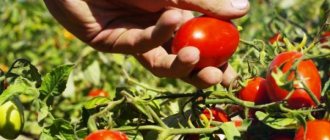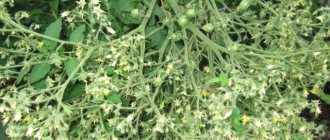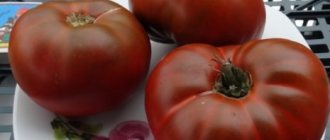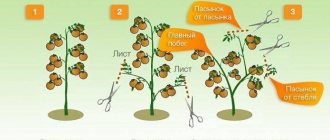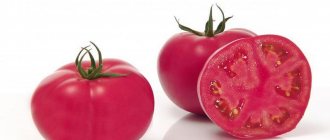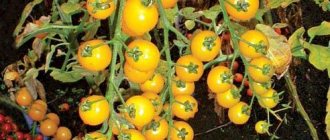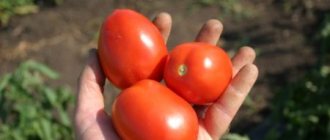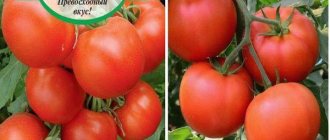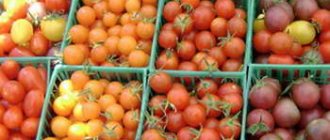Transfer to the site
Seedlings should be planted in open ground with the onset of May.
If Fatima is grown under a film cover or greenhouse, then the seedlings can be transferred even in mid-spring. 2-3 days before planting the bushes, you will need to treat the seedlings with agents that stimulate growth. Effective drugs include:
- Immunocytophyte.
- Epin.
When using such products, the growth of bushes and fruits will increase significantly. The Fatima variety should be planted in nutritious and rich soils. In this regard, it is necessary to treat the selected area with mineral fertilizer. At home, feeding is carried out using:
- Compost.
- Potassium humus.
- Phosphorus humus.
Before planting, the soil in the area is loosened, approximately 5 cm deep, in order to remove the crust. Now you can transplant the seedlings by making small holes for them. For each, the depth should not exceed 15 cm. It is recommended to use the 40x50 planting technique. All bushes must be planted at right angles, but if the seedlings are very tall, then a peg is immediately inserted, which is used for further staking of the plants.
Important! With light and fertilized soil, the variety will produce excellent yields, especially if you provide additional feeding during growth. Caring for the Fatima tomato variety is very simple, since there is no need to form bushes or get rid of stepsons
But based on the mass of tomatoes, each bush will definitely need to be tied up. Additionally, care includes watering and weeding the soil to remove weeds. It is best to keep the soil loosened and not let it reach the point where a crust forms. After planting, you can expect a harvest in 85-90 days
Caring for the Fatima tomato variety is very simple, since there is no need to form bushes or get rid of stepsons. But based on the mass of tomatoes, each bush will definitely need to be tied up. Additionally, care includes watering and weeding the soil to remove weeds. It is best to keep the soil loosened and not let it reach the point where a crust forms. After planting, you can expect a harvest in 85-90 days.
Description of the Fatima variety
You can read about the features of this tomato on packets of seeds and online on the websites of the above companies. Fortunately, the descriptions coincide, there are no significant contradictions, as happens with some varieties. Only gardeners dispute information from manufacturers. The Fatima bush is determinate, low - 40–60 cm. In fact, in a greenhouse and even in open ground in a favorable summer, a tomato can grow up to 1 m or higher, some even mistake it for an indeterminate (tall) variety.
The plant is spreading with drooping leaves. Ripening time is 85–90 days, the first flower cluster is laid above the 6–7th leaf. These characteristics make it possible to classify Fatima as an early variety, however, according to gardeners, there are tomatoes that ripen earlier in their beds.
The fruits are ribbed, heart-shaped and flat-round, and are fused. The stalk has “shoulders” - a dark green spot. When fully ripe, the skin turns pink or crimson. The pulp is fleshy, juicy and sweet, for which Fatima is called a dessert variety. Gardeners confirm these signs. The weight of one fruit reaches 400–600 g, but tomatoes more often grow at 200–300 g.
Fatima bush is low, the fruits are heart-shaped or round, sometimes fused
It is not difficult to guess why tomatoes in Russia do not behave exactly as Ukrainian producers promise: they are not zoned for our climate, but even in unusual conditions they produce delicious tomatoes. Fruiting is extended, ripening lasts until cold weather. In the conditions of the Ural or Siberian summer, only the first fruits will have time to ripen on the bushes; the rest must be collected at the stage of blanzhe ripeness.
The yield of the variety, according to various reviews, is within a rather vague range: from 1–2 kg per plant to 11 large fruits per bush. But these figures are relative, for example, in Altai, in open ground no more than 5 clusters manage to form, and in the south or in a greenhouse, where there are more sunny and warm days, the bush grows taller, and accordingly, the harvest will be richer. Some gardeners find that Fatima is similar in terms of ripening and hearth characteristics to Sevruga of Siberian selection.
The purpose of the variety is salad. Tomatoes can be eaten as fruit, they are ideal in salads, great for making juice, pasta and winter snacks such as vegetable caviar, horseradish, lecho, etc.
Diseases and disadvantages of the variety
Unlike its counterparts, this variety is considered one of the hardiest tomatoes with strong immunity. For this, both experienced vegetable growers and people without experience love him. It is not susceptible to late blight and is extremely resistant to other destructive diseases, such as powdery mildew. And if the plant still gets sick, you shouldn’t give up. Treatment with fungicides will quickly return the diseased bush to health.
Another issue is pests. A variety of insects can significantly spoil the rosy picture. To combat them, it is necessary to use disinfestation agents designed for this purpose.
The difficulty of collecting seed material has become a definite disadvantage of the variety. Inside, the Fatima tomato has a small number of chambers in which the seeds ripen for the next season. If a vegetable grower strives for complete independence from stores, then this feature will not be the most pleasant surprise. In all other aspects, Fatima tomatoes have no complaints.
Harvesting and storage rules
You can start harvesting at the end of July - beginning of August. Tomatoes are removed from the bushes as they ripen.
Considering the fact that the fruits practically do not crack, they can be stored fresh for quite a long time.
If you follow all the recommendations, Fatima tomatoes will delight you with a rich harvest of fruits of excellent taste. They can be used not only for personal consumption, but also for sale. The plants are unpretentious; a novice gardener can easily grow them.
Tomato Fatima is a pink, early-ripening variety of tomatoes. The variety was bred by Russian breeders more than 10 years ago. The tomato is popular among gardeners; it is successfully grown in agro-industrial complexes. It is loved by consumers for the delicate taste of its sugary and juicy pulp.
Agronomists and amateur gardeners pay tribute to its unpretentiousness, compactness and high yield. Already in the middle of summer you can collect large fruits of a rich pink color, and the bush will bear fruit all summer. Even novice gardeners can easily cope with caring for this variety and can even collect seeds for the next season.
The Fatima variety belongs to the low-growing group, the maximum height is just over half a meter; the bushes do not grow higher. Development occurs through the growth of lateral shoots; few stepsons are formed.
If the summer is warm and there is no heat, then pinching should be done regularly. But in hot and especially dry weather, the stepsons are not removed. The foliage will protect the bush from hot rays. There is no need to pinch the top - the plant does not grow higher than normal. There are exceptions - the bush can, under favorable conditions, reach a meter in height.
In open ground, a tomato ripens for about 90 days. Indeed, it ripens quickly and manages to produce several harvests. The fruits ripen until the second half of September.
Fruit characteristics and yield
During the flowering period, a single flower is tied at the top; it is quite large in size. This flower will give the best ovary and the largest fruit. All other inflorescences are collected in brushes. The first flower tassel can be found above the 6th leaf.
Tomato fruits have a ribbed surface and are shaped like a heart. Sometimes you can find fused tomatoes, the lower part is sharper, the upper part is round and voluminous. The stalk has so-called shoulders - this is a dark green spot. The ripe fruit has a rich, dense pink color or the distinct color of ripe raspberries.
The pulp is juicy and has a sweetish taste. Many gardeners consider this variety to be a dessert variety. The weight of a large fruit can exceed 0.5 kg. The average weight is approximately 250 g; from one bush you can harvest more than 2 kg of beautiful, tasty tomatoes.
In the photo below you can see what this variety of tomatoes looks like:
Harvesting and application
With good care and favorable weather conditions, the tomato will grow well, and therefore the harvest will please the owners. Ideally, one square can produce 10 kg of tomatoes per season. Harvesting can begin at the end of July. The collection is carried out as the fruits ripen. The peel of the Fatima variety, although not thick, is resistant to cracking, so they can be stored for a long period of time.
If you plan to store it for a long time, then slightly unripe fruits are collected. There should be no damage to them. It is convenient to place them in boxes lined with paper. The temperature in the room must be maintained. The ideal cellar is where the temperature is about +5 degrees.
Tomatoes will not last long in a dry room . Therefore, it is necessary to ensure a certain level of humidity during storage. The appearance of tomatoes does not deteriorate during transportation. Tomato juice, pastes, sauces and dessert tomatoes are prepared from this variety.
How to grow Fatima tomatoes?
The Fatima tomato variety can be grown in any region of the Russian Federation. The seeds are sown in March. Before sowing, the seeds must be treated with a weak solution of potassium permanganate. If the seed has been stored for more than a year, then before processing it is necessary to soak the seeds in warm water for several hours.
The plants do not need to form a bush; the stepsons do not need to be removed, but the branches must be tied to a support. If the seeds are purchased in a store, then they do not need to be processed, as this may harm them and they will germinate less well.
Before planting, you need to prepare the soil. You can use soil from your garden as soil. It may contain many pathological microorganisms and pests, so the soil must be disinfected. This is done by steaming the soil. The soil is placed in a colander and kept over boiling water for 10 minutes. Then the soil is poured into containers and grooves 5 cm deep are made in them. Several seeds are placed in each hole.
You can plant tomatoes in open ground in early May. If tomatoes are grown in a greenhouse, then the sprouts are planted in mid-April. 2 days before planting in the ground, the sprouts are treated with growth stimulants such as Epin, Immunocytophyte. These drugs can speed up the development of bushes.
Tomatoes need to be planted in soil enriched with mineral fertilizers. Therefore, before planting seedlings, the beds need to be treated with fertilizers, which should contain compost and humus. The soil on the site is first loosened by digging it approximately 15 cm deep so that there is no hard crust.
After planting in the ground, tomatoes need care. The plant needs to be watered regularly: in cloudy weather once a week, in warm sunny weather - every 2-3 days. Tomatoes need to be fertilized several times during the growing season. The first time fertilizing is applied 10 days after planting the seedlings in the ground. To do this, use fertilizers containing superphosphate, mullein and saltpeter.
How to get seedlings
Tomato Fatima is sown as seedlings approximately 2-2.5 months before the estimated time of planting in the ground. For seedlings, you need to prepare seeds, soil and containers.
Sowing directly into the beds is possible only in warm climates. Most often, the Fatima tomato is planted as seedlings.
Seed preparation
Before sowing, the seed material is processed . It is necessary to calculate so as to have time to grow the seedlings on time. It takes approximately 2 months to grow seedlings. It is noteworthy that if the weather is favorable, tomatoes can be sown immediately in open ground.
Before sowing, the seeds are soaked in manganese. If the seeds are stored for more than a year, then they must be kept in warm water for about an hour and a half. It is necessary that the seeds are saturated with moisture, and the shell covering the seed becomes soft and loose. Manganese is prepared at the rate of 2 g per 250 g of water.
Purchased seeds are most often not processed. The instructions on the package will tell you how best to sow the seed material.
Container and soil
Regular soil is suitable for planting.
In a special store you can buy it in packaged form. But it is advisable to treat even such soil - fry it in the oven or hold it over a stream of steam. The procedure takes 10 minutes. Containers are selected so that they have enough space for the formation of the root system. Cups should have drainage holes at the bottom.
The glass should not be lower than 10 cm . It’s good to use individual peat pots. You can sow a seed in a peat tablet.
Sowing
- The soil is laid out in the required containers, where grooves of about 5 cm are made.
- Place 2-3 seeds in one hole at a distance of 2 cm.
- Next, the furrows are filled with soil and watered well.
- To increase germination, it is recommended to cover the container with film, or simply cover it with glass.
- The seedlings are left in a warm place, for example, not far from the radiator.
Aftercare
The peculiarity of Fatima tomato seeds is that they are extremely small. They should be embedded in the ground to a depth of no more than 1.5 cm.
Seeds for seedlings are often sown very often.
Therefore, seedlings should be thinned out if necessary. There should be a distance of at least 5 cm between seedlings. Care features :
- Seedlings should be watered and loosened regularly.
- Add soil to the cups as needed.
- Provide even light and warmth for the entire period of growing seedlings.
- Approximately 7-10 days before planting in open ground or even under film, Fatima seedlings should be hardened. To do this, gradually lower the temperature in the room.
- About 3-5 days in advance, you need to use a growth stimulator and any drug that relieves stress in the plant and allows you to calmly endure the transplant procedure.
Antonina
I have been working as a gardener at a large enterprise for eight years now. We grow various fruits and vegetables over a vast territory and are the largest supplier of these goods in the region. As an employee, I constantly attend advanced training courses, study new varieties and approaches to growing.
In our entire company, tomatoes occupy the largest growing area. Because this vegetable is the most popular and in demand - at any time of the year they are purchased the most. It is tomatoes that I specialize in. I noticed that many gardeners I know are wary of new varieties or hybrids. There is an opinion that young varieties are unreliable and even dangerous.
Of course, this is complete nonsense. Yes, sometimes varieties turn out to be downright unsuccessful, but this is rare. Usually the results of modern selection are very good and do not have the disadvantages of older varieties. In this text I will talk about the Fatima variety - young and worthy of attention.
Characteristics of Fatima tomatoes
The young variety is not noted in the State Register, but its qualities are well known to many tomato lovers. The yield indicators of the Fatima tomato, judging by the reviews and photos of vegetable growers in different regions, far exceed the results of other low-growing hybrids. The quality of the fruit is usually rated above average. Disease resistance puts the variety at the forefront when choosing tomatoes for risky farming areas.
Productivity and fruiting
The Fatima variety is classified as a resistant early-ripening tomato that easily tolerates temperature fluctuations, lack of watering and is able to show the same yield under different weather conditions.
On average, up to 2 kg of tomatoes are harvested from one Fatima bush. With a planting scheme of 5 plants per 1 sq. m. possible yield exceeds 10 kg. In greenhouses and greenhouses, the variety shows average results and is used to produce tomatoes in the early stages for personal consumption. The short stature of the crop makes it unprofitable for mass commercial cultivation in greenhouses.
To improve results, tomatoes are placed in areas exposed to the sun and given at least two fertilizing treatments per season.
Area of application of fruits
The purpose of Fatima tomatoes is universal. The predominance of pulp and excellent taste allow the fruits to be processed into purees, pastes, and juices. But most often tomatoes are consumed fresh. Their durable peel does not crack, allowing the crop to be stored and transported for a long time.
The variety is not used for whole-fruit canning due to its large size. Can be used for preparing prefabricated salads and pickles.
Resistance to diseases and pests
The variety is genetically resistant to most tomato diseases, due to early ripening, and is not damaged by fungal infections.
The resistance of bushes to late blight is increased. When describing the Fatima tomato, all gardeners note that the variety perfectly resists infection even against the background of disease in surrounding crops.
Tomato is immune to Fusarium wilt, verticillium blight, and Alternaria blight. Healthy bushes rarely attract pests.
Advantages and disadvantages of the variety
The main advantage of the Fatima variety is its ease of cultivation, which is noted by both experienced and novice gardeners. The culture is unpretentious, responsive to minimal care and feeding.
Advantages of the Fatima tomato variety:
- early ripening;
- excellent taste;
- large fruits of original shape;
- resistance to diseases.
Over a decade of cultivation, no noticeable deficiencies have been identified in the Fatima tomato. Its varietal characteristics characterize it as one of the best low-growing early varieties. The only inconvenience during reproduction is the small size and small number of seeds in the fruits, which, in turn, is a plus when eating them.
Farmer reviews
Among those who have at least once tried to grow such tomatoes, it is difficult to find dissatisfied ones.
Some praise them for their significant yield, while others are pleased with their resistance to disease. Some vegetable growers, despite the fact that the variety does well without pinching, still perform a similar procedure. The result: large and juicy fruits that truly amaze with their chic appearance.
There is also an important remark. Tomato seedlings cannot boast of their presentation ; for this reason, vegetable growers who do not know the variety often bypass it when purchasing. However, as experts say, there is no need to be afraid of this, since the result will be higher than any expectations.
Disease and pest control
Tomatoes have a good immune system, but this does not mean that this variety is invulnerable to diseases and pests.
Traumatic factors such as lack of nutrition, weather conditions (rains, strong winds, drought) can significantly reduce the plant’s immunity. Weakened, it becomes more susceptible to disease or damage by pests.
The fungus that most often attacks nightshades loves a moist environment, so you need to water your tomatoes sparingly. It is advisable to do this during the day so that the water has time to be absorbed by the evening.
Plantings should not be dense. In August, when it is hot in the morning and cold at night, they need to be covered. Do not overuse chemicals to combat late blight. It is better to use biological drugs. Fitosporin has proven itself well.
Tatyana Orlova (Vasilidchenko) (candidate of agricultural sciences):
While the tomatoes still have neither ripe nor browned fruits, chemical fungicides can be used to suppress fungal diseases; they are more effective. These are the drugs Ridomil Gold, HOM, Abiga-Peak. Finish their use 3 weeks before harvesting. If the risk of late blight remains, switch to biological preparations such as Fitosporin.
The first time is sprayed when the ovaries appear, then every two weeks. You can use folk remedies:
- periodically sprinkle the rows of tomatoes with wood ash;
- prepare a solution of iodine with milk - pour 1 liter of skim milk into a bucket of water, add 15 drops of iodine, spray once every 2 weeks;
- prepare an infusion: chop 100 g of garlic, pour in a glass of water, leave for 24 hours, strain, pour into a bucket, add 1 g of potassium permanganate, stir, use once every 14 days, 0.5 liters for each bush.
Chemical and biological products, herbal infusions and decoctions are suitable for pest control.
https://profermu.com/ogorod/pomidory/sorta-p/fatima.htmlhttps://orchardo.ru/33011-tomat-fatima-harakteristika-i-opisanie-sorta.htmlhttps://pro100ogorod.ru/tomaty/ fatima-description.html
Features of cultivation
In Ukraine, Fatima is grown through seedlings or sowing in the ground. The website has recommendations on how to sow this variety for seedlings:
- start sowing 50–60 days before planting in a permanent place;
- pre-treat the seeds with a 1% solution of potassium permanganate;
- use light and fertile soil;
- seed placement depth is 1–1.5 cm.
Standard seedling care:
- water as the soil dries;
- in the phase of 1–2 true leaves, pick into pots;
- Feed with nitrogen-containing fertilizer 2–3 times with an interval of 10–14 days;
- a week before planting, start hardening, gradually accustoming them to conditions outside or in a greenhouse.
Southerner Fatima loves a lot of light and warmth; in Russian regions she will be more productive in a greenhouse. The best predecessors: cabbage, cucumbers, carrots, onions, legumes. The variety responds well to mineral fertilizers. Before planting, add nitroammophoska or a special fertilizer for tomatoes to the soil. You can also use organic matter: compost, humus, wood ash. The planting pattern for Fatima is 70x30–40 cm. Immediately tie the bushes to supports or a trellis.
While looking for reviews and descriptions of the tomato, Fatima made a useful discovery. Maybe someone else doesn’t know either. You can tie tomatoes not only vertically, but also horizontally, to a wire or mesh stretched between posts. Such recommendations are given on one of the Ukrainian sites, in information about growing Fatima. This is interesting, especially for the northern regions, the bushes turn out to be low, and at the beginning of summer and autumn it will be convenient to cover them with spunbond.
The principle of bush formation depends on its growth vigor and the climate in the growing region. If the plant is tall and powerful, then leave 1–2 stems and remove all excess shoots. In cool and short summer conditions, Fatima grows compact, but despite this, the number of clusters must be normalized so that all the fruits have time to fill. For example, leave 5 clusters that started first in the open ground, in a greenhouse - 8. In any case, remove all side shoots growing in the axils of the leaves below the first flower cluster, as well as flowers that appear later than a month before the onset of cold nights.
There are also recommendations during flowering in cold weather (at night +13 °C and below) or, conversely, hot weather (above +32 °C) to spray with ovary formation stimulants: Bud, Ovary or boric acid solution (2 g per 10 liters of water) . If the weather has not improved in 2-3 days, repeat the spraying.
The rest of Fatima's care is:
- watering 1-2 times a week;
- fertilizing with complex mixtures for tomatoes twice a month;
- mulching between rows or loosening the soil after each watering or rain.
Description of tomato variety Fatima with photo
Tomato Fatima is an early ripening variety, the crop is intended for cultivation in open ground and under temporary film covers in areas with different climates.
In the southern regions, tomatoes are grown by direct sowing of seeds into the soil.
The plants are of a determinate type, they are short-growing, and in open ground they grow no higher than 60 cm. The bushes are spreading and complete the growing season on their own. Not a full cluster of flowers appears at the top, but one flower. Moderate cultivation is recommended for the crop. Despite the small height of the bush, it requires a garter. Weak stems without support cannot support the weight of the fruit.
Large Russian seed companies do not sell the Fatima variety. Seeds can be purchased mainly from amateur breeders. Because of this, discrepancies often occur between the cultivation results and the description of the crop. When re-cultivated from your own seeds, splitting or deviation from the declared characteristics may also occur.
Warning! They sell a hybrid of German origin under the name Fatima F1, which is recommended for greenhouses, has a tall bush and red fruits.
Description of fruits
The tomatoes are heart-shaped with pronounced ribbing. Average weight - 250-350 g. Unripe fruits are light green with more contrasting shoulders. When ripe, the color becomes soft pink. And the stain disappears if the plants received balanced fertilizers.
The skin of the fruit is thin. Inside, Fatima tomatoes are multi-celled with juicy and fleshy pulp. The seeds are small. The taste is sweet, there is a pleasant aroma. Tomatoes do not crack on the bush even after harvesting. They can be stored for a short period and transported in a neat layout.
How to grow tomatoes
In order for the harvest to be good, it is necessary to ensure proper planting, care and take into account all the features and difficulties of growing the Fatima variety.
Landing:
- Tomatoes should be planted in a sunny place. Shading will reduce the yield.
- The bed should be dug to a depth of 15 cm.
- When digging, a complex of fertilizers is applied. If the soil is heavy, then you need to add compost, sandy soil or humus.
- There should be no more than 5 plants per square. If you plant in a checkerboard pattern, you need to keep a distance of about half a meter.
- Seedlings should be planted to a depth of approximately 10 cm.
Bush care
No special care is required; it is enough to regularly remove weeds and keep the soil moist, as well as periodically loosen it.
Proper care:
- Large, quickly filling fruits will require more nutrition. When forming a crop, fertilizing with complex potassium-phosphorus fertilizer is good.
- Manure and nitrogen fertilizers are not suitable for fertilizing - the green mass will increase.
- Tomatoes should be watered abundantly, in drought conditions at least 2-3 times a week.
- Mulch the soil with organic residues, use dry grass, sawdust or humus. Mulch will reduce water evaporation and keep the soil loose.
- Plants should be tied up as needed, without breaking the stems. Each bunch must be supported.
- There is practically no need for stepsoning - the bush forms on its own.
Features and possible difficulties
The bushes are low-growing, and the mass of fruits is quite heavy, so it is necessary to tie up the branches.
In order for the bush to form well and the fruits to be juicy, you need to monitor the humidity. A dry plant develops slowly. On cloudy days, water no more than once a week.
Fertilizers must be added during the growing season. On the 10th day after planting the seedlings - mullein, saltpeter and superphosphate.
Nuances of agricultural technology
This variety of tomato can be grown in greenhouses under film and in open ground. The plant is light-loving, so natural sunlight is most suitable for it. When growing in greenhouses, it is better to purchase seeds of the F1 hybrid. It is adapted to greenhouse conditions, is not so demanding on lighting and produces a good harvest in such conditions.
Seedlings must be planted in open ground with the onset of May. If Fatima is grown under a film cover or greenhouse, the seedlings can be transferred even in mid-spring.
When using such products, the growth of bushes and fruits will increase significantly. The Fatima variety should be planted in high-calorie and rich soils. In this regard, it is necessary to treat the selected area with mineral fertilizer.
At home, feeding is done using:
- compost;
- potash humus;
- phosphorus humus.
Important! With light and fertilized soil, the variety will provide excellent yield, especially if auxiliary feeding is provided during the growth period.
Features of cultivation
Tomato Fatima is grown both by seedlings and by sowing seeds directly into open ground. The seedling method allows you to speed up the ripening period, and for cold regions it is the only possible method of cultivation.
When sowing, shallow containers with drainage holes are required. They are pre-cleaned and washed with antiseptic agents. The soil for planting is mixed from turf soil, peat and humus. To make the structure light, add river sand, rotted sawdust or vermiculite.
Seeds and soil are disinfected with a solution of a fungicide, for example, Fitosporin.
The seeds are laid out on compacted and moistened soil. Cover with a thin layer of peat or soil mulch, which is also lightly pressed. This allows the sprout to free itself from the thick seed coat. If the seedling hatches along with it, then it is necessary to wet it with water to soften it and carefully remove it with tweezers. Otherwise, the plant will not develop properly.
Important! When shoot loops appear on the surface, the containers are placed in places with sunlight or special artificial lighting.
To prevent the stems from stretching excessively, they should be straightened in the light. At the same time, the temperature is reduced for one week so that during the daytime it is +16°C, at night – +14°C. This promotes better absorption of beneficial microelements from the soil and accelerates the development of the root system.
Picking is carried out when several well-developed leaves appear. The strongest plants are replanted, because weak seedlings will lag in growth throughout the growing season.
Tomatoes are ready for planting when the first flower cluster appears. For replanting, it is also necessary that at night the air temperature exceeds +10°C, and the soil warms up to a depth of 10-12 cm. To warm open ridges more quickly, dark covering material is applied to them.
Advice! The day before transplanting, water the plants so that the earthen ball does not crumble when transferred to the hole.
The Fatima variety is suitable for compact cultivation - per 1 sq. m are planted in 3-4 pieces. When positioned in a line, 40-50 cm are left between the plants. The ridges are well loosened and weeds are removed, including between rows and in adjacent areas.
It is recommended to grow tomato with a garter
The determinate variety is placed separately from tall species to avoid shading and suppression of plants.
A handful of fertilizer and ash is added to the holes and watered abundantly several times so that an earthen slurry forms at the bottom of the planting hole. Tomatoes are planted in it without being buried. Then they are covered with soil and be sure to squeeze at the roots.
To increase productivity, Fatima tomato is fed about four times during cultivation. Water moderately. During the period of fruit filling, the amount of moisture is reduced and resumed after harvesting. Then the soil is loosened to avoid crust formation, or a mulch layer is applied.
Care after transplant
Like all other plants, Fatima tomato bushes need care. The bushes will not develop well in soil that is too dry, so watering will have to be done regularly.
If cloudy days prevail, this event should be organized once a week. For hotter and sunny days, the interval between waterings is reduced to two to three days.
Tomato plants need to be fed several times during the growing season. The first time such an event is held ten days after transplanting the seedlings into unprotected beds. For this purpose, special compositions are used, made on the basis of mullein, nitrate and superphosphate.
Among other things, the soil between the bushes must be loosened periodically to ensure oxygen access to the root system. At the same time, weeds are also removed.
Pest and disease control
The resistance of Fatima tomatoes to infections does not mean their absolute invulnerability. Viable bushes are able to grow and bear fruit almost without care, but any traumatic factors (drought, rain, lack of nutrition) reduce the plant's immunity. Weakened tomatoes become more susceptible to disease and are more readily visited by pests.
If spots are found on the leaves or stems of plants, the tomatoes are treated with fungicidal agents, since of all diseases, Fatima tomatoes are characterized by fungal infections.
Insecticidal preparations for typical tomato pests are selected individually
It is important to complete the processing 20 days before harvesting the next batch of ripe fruits
The high-yielding Fatima tomato is a real find for beginning gardeners and summer residents who rarely visit their plot. The variety is able to withstand extreme weather conditions while maintaining an excellent harvest. Large pink fruits have a distinct taste and ripen from July to September, which is very convenient for personal consumption.
Tomato Fatima is an early variety of pink tomatoes bred in Russia. Over the 10 years of its existence, the hybrid has firmly established itself in dachas and vegetable gardens in all climatic zones of the country. Among its brethren, the variety is distinguished for its ability of compact, unpretentious bushes to produce high yields of large, sweet tomatoes. The Fatima tomato is especially recommended for beginning gardeners. It is easy to grow and can be propagated from your own seeds.
Valery Ivanovich, 52 years old, Rostov region I first learned about Fatima tomatoes from reviews and photos on forums; the yield was promised to be small, but for such low bushes this is a lot. For the first time I planted purchased seeds directly into the beds. The germination rate was pleasantly surprising: out of 30 seeds, 20 sprouted. Afterwards, I planted them less frequently and got beautiful bushes only half a meter high, but the harvest was more than enough.
Until the fall, I collected it for salads and distributed it to neighbors. I have been growing it from my own seeds for several years. I have not found any equal to these tomatoes in taste and appearance. Now Fatima is my favorite of the pink varieties. Marina Solovets, 38 years old, Zelenograd, grew Fatima tomatoes through seedlings for the greenhouse. The sprouts are really frail looking.
It's time to plant them, but they are thin and flimsy. I planted it, but didn’t expect any results. And they grew up and became stronger. Then I didn’t expect that the fruits would be so large - several bushes simply lay on the ground under the weight of the tomatoes. Now I know that behind the unsightly appearance there will be a good harvest and very tasty tomatoes. Next year I will plant this variety again.
Caring for tomatoes in the ground
Tomatoes need regular watering, fertilizing, and loosening.
In hot weather, water every 3 days; in cloudy weather, once a week is enough. They do this by irrigation, directly under the bush.
During the period of growing green mass, they are fed with nitrogen fertilizers, when fruits begin to form - with potassium and phosphorus.
After each moistening, you need to loosen the soil and remove weeds. Hill up regularly so that the roots are saturated with oxygen. Tomato stems should be tied up.
Errors during cultivation
Do not over-moisten the soil in the garden bed. Avoid the formation of a dry crust.
Secure tomato stems only with synthetic materials; fungus may appear in natural ones.
Growing rules
The Fatima tomato is not picky and resistant to weather surprises, but gardeners adhere to certain conditions even when growing such a life-loving variety.
The looseness of the soil, its fertility, and maximum illumination during the day are the factors that tomatoes need for normal development. Regular watering during dry times will ensure uniform formation of fruits and their evenness on one bush.
The Fatima variety is recommended for open ground. Tomatoes are sown directly into garden beds only in the southernmost regions, so in most of the country the seedling method is used.
Planting seedlings
Sowing of Fatima seeds for seedlings begins in March, calculating the time so that planting in open ground occurs upon the onset of stable warm weather. Early tomato seedlings are ready for transfer to a permanent location after 30 days.
Frail and delicate-looking sprouts, when transferred to open ground, quickly gain strength and turn into strong plants.
Any loose, fertile soil is suitable for growing young tomatoes from seeds. It is convenient to sow seeds in ready-made mixtures offered by garden stores. The use of garden soil is possible only after disinfection. To destroy pathogens and pests, the soil is heated in the oven, treated with steam, or spilled with a hot solution of potassium permanganate.
Containers for planting tomatoes must provide sufficient conditions for the formation of a healthy root system. Glasses with seedlings must have drainage holes, and their height should not be less than 10 cm. Fatima tomatoes are recommended to be sown in individual peat pots. Since the seedlings of this variety are not vigorous, special care will be required when transplanting.
Fatima's seeds are small, so they are planted in the soil no deeper than 1.5 cm. When planting in rows in boxes, the tomato seedlings that appear must be thinned out, leaving about 5 cm between plants.
All care for sprouts consists of regular watering and uniform lighting. Before planting in the ground, it is advisable to strengthen the tomatoes. A week before the procedure, tomatoes begin to harden, and 3 days before they are sprayed with growth stimulants.
Transfer
Choose the sunniest place for Fatima tomatoes. Even slight partial shade will reduce yield. Tomatoes have no great requirements for soil. It is enough to dig the beds to a depth of 15 cm, adding complex mineral fertilizers. On heavy soils, add humus, compost and sand.
The Fatima tomato planting scheme assumes placement on 1 square. m. no more than 5 plants. You can arrange the holes in a checkerboard pattern, leaving 40 cm between the bushes.
Thin stems may not support the weight of large tomatoes. When planting Fatima tomatoes, it is advisable to immediately provide for the installation of supports.
Young bushes are planted vertically in prepared, well-moistened holes or furrows. Fatima seedlings are low, the depth of its planting is no more than 10 cm.
Aftercare
A sustainable crop does not require special care. Regular removal of weeds and keeping the soil moist and loose are sufficient conditions for the development of the Fatima tomato.
Rules for caring for tomatoes:
- Large, quickly filling fruits require increased nutrition. During the period of crop formation, it is useful to water the bushes with complex potassium and phosphorus compounds. Fertilize the beds twice a season, avoiding manure and nitrogen fertilizers.
- Tomatoes are watered during a long absence of precipitation. In dry times, tomatoes are moistened 2 times a week.
- Mulching the soil with organic residues, sawdust or humus reduces moisture evaporation and ensures a loose soil composition, which reduces labor costs when caring for tomatoes.
- Plants are tied regularly as the ovaries form. It is advisable to provide support for the branches near each bunch of tomatoes.
Since the Fatima variety does not require pinching and independently forms a harmonious bush, the listed rules are the maximum list of care measures to obtain a high yield.
Description
Bushes of the Fatima variety are small, their height is no more than 60 cm. They are strong and each bush is productive. If you know all the subtleties and rules for caring for tomatoes, then you can get 10 kg of fruit from every square meter.
Tomato Fatima is an early ripening variety, the fruits are quite large and belong to the dessert variety. A positive feature is the duration of fruiting, until autumn. It is worth noting that you can buy seeds of a hybrid species, which has a similar name, but there is an F1 prefix. Description of the Fatima F1 tomato, its characteristics will be different. The hybrid is a mid-season species, the bushes are tall and it is better to grow them in a greenhouse or film shelter.
People who constantly grow the variety give only positive descriptions of the Fatima tomato variety. The fruits have a pleasant sweet taste, high juiciness, and fleshy pulp. The color of the tomato is pink, the size is quite large, reaching 200-400 grams. This type is suitable for salads, fresh consumption, and for the production of juice, sauce, paste or winter preparations.
Additional advantages of Fatima are that the peel does not crack, which allows you to store tomatoes for a long time. The positive qualities of tomatoes include:
- Excellent taste.
- High calorie content of each tomato.
- Good immune system.
- The tomato does not crack when ripe.
It is very difficult to find flaws, since the breeders did a good job creating this species. Weaknesses include only some difficulties in collecting seed material, because there is not so much of it. Description and visual features can be seen in the video:
Characteristic
Description and characteristics of the Fatima tomato variety will help beginners study its distinctive features in more detail.
The plant belongs to the early ripening varieties of tomatoes, which ripen literally a few months after planting the seedlings in open ground. Mature bushes grow up to 45-70 centimeters. When grown in greenhouses, their height can be more than 80 cm. Over time, quite large fruits weighing about 500 grams are formed on the bushes. On the outside they are covered with a reddish smooth skin, under which there is a fleshy texture. The taste of the fruit is sweetish and very pleasant.
The main advantage of this variety is its resistance to diseases. The plant almost never suffers from late blight, as evidenced by numerous reviews from people who grow Fatima tomatoes.
Fruit characteristics
With proper and competent care, the variety can become surprisingly productive - you can harvest up to 10 kilograms from one bush. With less careful care, the variety does not lose much in yield.
The fruits, as mentioned above, are large. The average weight can be very different - from 200 to 400 grams. Fatima's shape most closely resembles a heart - most tomatoes have exactly this shape. The peel color is reddish-pink.
In terms of taste, Fatima is rated very highly. The fruits have a sweetish, pronounced taste and a pleasant tomato smell. In addition, this crop is famous for its fleshy fruits, which contain relatively little liquid.
Advantages and disadvantages
Advantages of the Fatima tomato:
- Large fruit and high marketability;
- Good taste;
- Early maturation;
- Good yield (as for a determinate variety);
- Disease resistance;
- Easy care.
The variety has no obvious disadvantages.
The most important advantages of this tomato are:
- size of ripened fruits;
- excellent taste and commercial characteristics;
- versatility in application;
- good disease resistance;
- excellent productivity.
Gardeners have not noted any shortcomings, which has allowed it to occupy a leading place in the garden beds for many years now. It takes up to three months from planting the seeds to ripening the fruit.
The plant is considered heat-loving and requires sufficient sunlight.
One of the advantages is that the weight of Fatima fruits can reach 400 grams
Based on the characteristics, we can highlight the following advantages of the Fatima variety:
- unpretentious, requires minimal care;
- early ripening;
- friendly return of the harvest;
- resistant to diseases;
- good preservation.
Disadvantages of the variety: slow growth of seedlings, produces a small amount of seeds, the bush requires garter.
Since the variety is super-determinate, judging by the description, it does not require garter.
